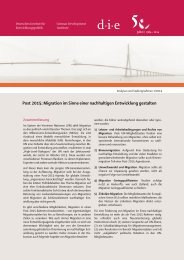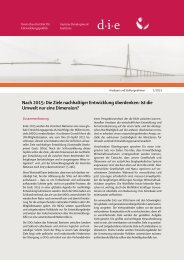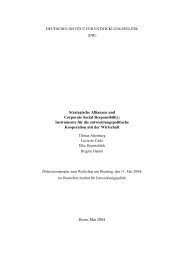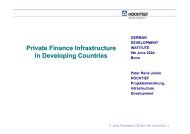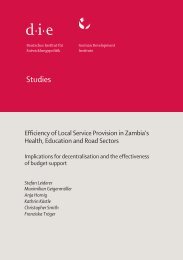Middle East / North Africa and the Millennium Development Goals ...
Middle East / North Africa and the Millennium Development Goals ...
Middle East / North Africa and the Millennium Development Goals ...
Create successful ePaper yourself
Turn your PDF publications into a flip-book with our unique Google optimized e-Paper software.
154<br />
Markus Loewe<br />
A recent IMF working paper 13 also comes to <strong>the</strong> conclusion that higher<br />
expenditure for education <strong>and</strong> governance reforms is at once essential for<br />
<strong>the</strong> implementation of MDG2 <strong>and</strong> MDG8 <strong>and</strong> <strong>the</strong> most effective <strong>and</strong> efficient<br />
approach that can be used to (i) accelerate economic growth, (ii) to<br />
alleviate income poverty <strong>and</strong> hunger, (iii) to contribute to gender equality<br />
(MDG3), <strong>and</strong> (iv) to reduce child mortality rates (MDG4).<br />
Improving political <strong>and</strong> economic governance in <strong>the</strong> MENA countries is<br />
especially urgent (GTZ 2003, 5 f.). According to IMF calculations, qualitative<br />
differences in <strong>the</strong> institutional framework can explain almost three<br />
quarters of <strong>the</strong> income differentials between <strong>the</strong> developing countries<br />
(Bundesregierung 2004, 34).<br />
But it would also be important to improve <strong>the</strong> quality of schooling in <strong>the</strong><br />
MENA countries. It is <strong>the</strong> kind of education <strong>the</strong>y receive (<strong>and</strong> not <strong>the</strong><br />
number of school years completed) that determines whe<strong>the</strong>r <strong>and</strong> to what<br />
extent school graduates will be able to make use of <strong>the</strong>ir education. It is<br />
only education designed to teach children to learn on <strong>the</strong>ir own, to think<br />
critically, <strong>and</strong> to develop <strong>the</strong>ir creative skills that enables <strong>the</strong>m to take<br />
charge of <strong>the</strong>ir own lives, to process information adequately, <strong>and</strong> to take a<br />
h<strong>and</strong> in shaping <strong>the</strong> political, economic, cultural, <strong>and</strong> technological development<br />
of <strong>the</strong>ir country (AFESD / UNDP 2003; Weiss 2004b, 5).<br />
Any more intensive commitment of DC to gender equality should not consist<br />
of women’s-promotion measures that are simply added on to existing<br />
projects or programs (e.g. in <strong>the</strong> sectors education, microfinance, SME<br />
promotion). This must instead be seen as a cross-cutting task. As early as<br />
in <strong>the</strong> planning phase of DC projects it is important to factor in potential<br />
impacts on gender relations. It should never be assumed a priori that a<br />
given DC measure is gender-neutral. Women can always be promoted or<br />
disadvantaged by a given measure as such, <strong>and</strong> in <strong>the</strong> formulation of mea-<br />
13 The authors of <strong>the</strong> paper (Baldacci et al. 2004) present <strong>the</strong> results of a regression analysis<br />
based on panel data on 120 developing countries, <strong>and</strong> <strong>the</strong>y look into <strong>the</strong> direct <strong>and</strong><br />
indirect effects of five possible government interventions: (i) an increase of spending for<br />
education amounting to 1% of GDP, (ii) an equal rise in spending for health, (iii) a reduction<br />
of government spending equivalent to 1% of GDP, (iv) a 10 % reduction of <strong>the</strong><br />
inflation rate, <strong>and</strong> (v) significant improvement of performance on <strong>the</strong> governance indicators.<br />
The dependent variable used in <strong>the</strong> model included in particular (a) level of economic<br />
growth, (b) <strong>the</strong> proportion income-poor persons among <strong>the</strong> population, (c) school<br />
enrolment rates for boys <strong>and</strong> girls, <strong>and</strong> (d) <strong>the</strong> child mortality rate.<br />
German <strong>Development</strong> Institute



